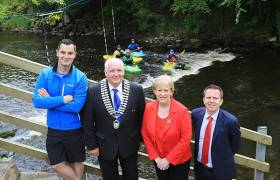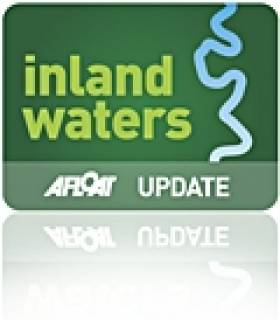Displaying items by tag: Shannon Erne Waterways
Shannon–Erne Blueway Launched in Ballyconnell, Co Cavan
Minister Heather Humphreys T.D., in conjunction with broadcaster & fitness expert Karl Henry, Waterways Ireland Chief Executive Dawn Livingstone and Cavan County Council Cathoirleach Paddy Smith has launched the Shannon-Erne Blueway in Ballyconnell, Co Cavan. The Shannon-Erne Blueway adds significantly to the network of Blueway trails that Waterways Ireland has developed along the navigations.
The Shannon–Erne Blueway runs from Leitrim Village to Belturbet and includes 70km of water trail and over 17km of linear and looped walking and cycling routes. The Shannon-Erne Blueway provides a range of recreational leisure activities such as paddling, walking and cycling all linked by the waterways to local towns and villages.
Minister Humphreys stated “This is a wonderful amenity which is a great addition to Cavan and Leitrim’s tourism offering. The development of Blueways across the country is an important element of the Government’s tourism strategy. Towns and villages along the Shannon-Erne route will now be able to capitalise on the increased level of visitors who will come to the region to use the Blueway for a range of recreation activities. More visitors will bring more revenue for local businesses and should boost local job creation. I would like to commend Waterways Ireland, the local authorities and the tourism agencies which have collaborated to bring this project to fruition.”
The Shannon-Erne Blueway has the potential to have a very positive impact on jobs and the regional economy. The Mayo Greenway, which is now in its 6th year of operation, has seen a jump in visitor numbers from 80,000 in 2011 to 300,000 in 2014. That means an extra €5 million was brought into the region. With the market for off road adventure tourism is growing here in Ireland and internationally, Cavan and Leitrim are in a prime position to benefit from this trend.
The launch of the Blueway will allow local businesses to capitalise on an increase in demand for transport, equipment hire, accommodation and entertainment.
Paddy Smith, Cathoirleach Cavan County Council said ' I’m very proud to be here today in Ballyconnell to launch the new Shannon – Erne Blueway . Cavan is blessed with a network of scenic waterways which can rival any in the country. We are delighted to link in with Waterways Ireland and Leitrim County Council to develop and promote the new Blueway linking the Shannon and Erne Rivers. The opportunities for recreational activities along the Blueway are many and we’re confident that visitors will want to experience all that it has to offer’
The Shannon Erne Blueway is a new concept where a myriad of recreational activities have been developed and bundled together as a single or multiple visitor experience and tourism proposition. Waterways Ireland has, using the wonderful waterway assets, also developed and built a paddling trail from Drumshanbo through Battlebridge and Leitrim Village to Carrick on Shannon.
The Shannon-Erne Blueway is being delivered by Waterways Ireland in partnership of the Cavan County Council, 'This is Cavan', Canoeing Ireland, Leitrim County Council, Leitrim Tourism and Fáilte Ireland.
Chief Executive Dawn Livingstone confirmed that partnership was the key to delivering the Shannon Blueway "Waterways Ireland provides world beating facilities and services on the Shannon Navigation and Shannon-Erne Waterway. Through our partnership with the National Trails Office, Canoeing Ireland, Cavan County Council, 'This is Cavan', Leitrim Tourism and Leitrim County Council an outstanding multi-activity product has been built in the Shannon-Erne and Shannon Blueways which is now being packaged by clubs and communities for their recreational activities and companies and organisations for domestic and international tourists. Partnership is key to delivering the future of the Shannon Blueway further into Roscommon, Longford and on down the Shannon as well as north onto Lough Erne."
The Shannon Erne Blueway is at the heart of 200km of paddling area, looped and linear walks.
Powerboat Racing Garadice Lake – Haughton's Shore
Powerboat Racing will take place at Haughton's Shore, Garadice Lake on the Shannon Erne inland Waterway from Sun 18th July 2010 from 09.00 hrs to 18.00 hrs.
Through traffic will be catered for between races. Waterways Ireland has requested Masters of vessels are requested to proceed at slow speed and with minimum wash when passing this stretch of the navigation and to heed any advice or instructions issued by the race officials.






























































